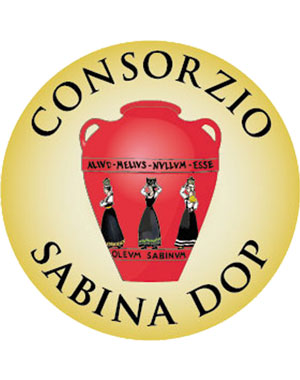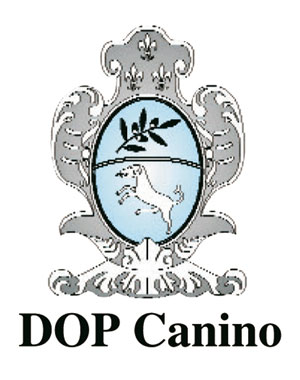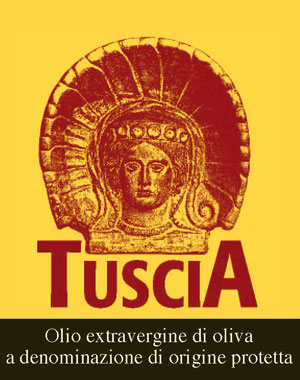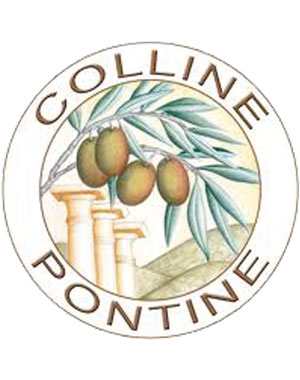Latium region produces four extra virgin olive oils which are protected by the PDO, a Protected Designation of Origin: Sabina, Canino, Tuscia and Colline Pontine.
The sizeable output of the olive oil in this particular region, equates to about 80,000 hectares with an annual production of around 26,000 tons of olive oil, which is 5% more of the share of total national production. In the Latium region alone, there are about 300 olive oil mills throughout area. One third of the olive oil mills still utilize the traditional grindstones, whereas the remaining mills are equipped with olive oil presses, which utilize modern continuous cycle machines with hammer crushers and centrifugal extraction. Regional production capacity ranges from 20,000 to 35,000 tons of olive oil per year. Olive farming is very widespread and established within the region, and offers sizeable margins of growth in terms of quality and quantity of olive oil produced.
Sabina PDO extra virgin olive oil
 Sabina is an area in which the entire agricultural landscape is dominated by the outlines and shapes of olive groves. Cultivation of the olive tree and the timeless traditions that go with it date back thousands of years as is evident by the majestic trees, which are guarded fiercely by their farmers. The extra virgin olive oil from Sabina was one of the first ones to receive the PDO Denomination. The main cultivated olive varieties are Carboncella, Leccino, Raja, Pendolino, Frantoio, Moraiolo, Olivastrone, Salviana, Olivago, and Rosciola for minimum 75%. Other olive varieties, up to 25% can be added as well. What is especially outstanding about the olive oil from this area is its low acidity, which reaches a maximum peak of 0.6%. Olive oil color is golden yellow, with tints of green in younger olive oil. The aroma and the flavor is fruity, velvety, uniform, aromatic with a slightly pungent hue. A bitter note is more pronounced in younger olive oils, but this fades over time.
Sabina is an area in which the entire agricultural landscape is dominated by the outlines and shapes of olive groves. Cultivation of the olive tree and the timeless traditions that go with it date back thousands of years as is evident by the majestic trees, which are guarded fiercely by their farmers. The extra virgin olive oil from Sabina was one of the first ones to receive the PDO Denomination. The main cultivated olive varieties are Carboncella, Leccino, Raja, Pendolino, Frantoio, Moraiolo, Olivastrone, Salviana, Olivago, and Rosciola for minimum 75%. Other olive varieties, up to 25% can be added as well. What is especially outstanding about the olive oil from this area is its low acidity, which reaches a maximum peak of 0.6%. Olive oil color is golden yellow, with tints of green in younger olive oil. The aroma and the flavor is fruity, velvety, uniform, aromatic with a slightly pungent hue. A bitter note is more pronounced in younger olive oils, but this fades over time.
Canino PDO extra virgin olive oil
 Renowned for its long PDO history in the Latium region, this olive oil is produced around the province of Viterbo, an area of Latium renowned for olive oil orchards that date back to Etruscan times.
Renowned for its long PDO history in the Latium region, this olive oil is produced around the province of Viterbo, an area of Latium renowned for olive oil orchards that date back to Etruscan times.
The main cultivars are Canino, a local olive variety, Leccino, Pendolino, Maurino and Frantoio, which are added alone or blended. The acidity of this olive oil ranges from 0.15% to 0.5% and is one of the lowest among Italian extra virgin olive oils. The olive oil is green in color, with golden hues, has a fruity aroma and a pronounced flavor, which is slightly pungent and has a bitter aftertaste when the oil is young.
Tuscia PDO extra virgin olive oil
 The third PDO olive oil from this region is called Tuscia, which joined the protected class designation in 2005. The protected designation extends to the 52 municipalities across the province of Viterbo, and includes three additional sub-areas of Viterbo: Colli Cimini, Collina Viterbese and Lago di Bolsena. The local Canino olive, a smaller and slower to mature olive variety, yields an olive oil with very low acidity which is green in color, has a fruity aroma and a distinctive flavor. Other olive varieties include Frantoio, Moraiolo and Leccino, as well as Grognolo, Fuscurella, Maurino and Pendolino.
The third PDO olive oil from this region is called Tuscia, which joined the protected class designation in 2005. The protected designation extends to the 52 municipalities across the province of Viterbo, and includes three additional sub-areas of Viterbo: Colli Cimini, Collina Viterbese and Lago di Bolsena. The local Canino olive, a smaller and slower to mature olive variety, yields an olive oil with very low acidity which is green in color, has a fruity aroma and a distinctive flavor. Other olive varieties include Frantoio, Moraiolo and Leccino, as well as Grognolo, Fuscurella, Maurino and Pendolino.
Colline Pontine PDO extra virgin olive oil
 Colline Pontine received its PDO protected denomination in 2010. The characteristics of this olive oil are described in recorded documents which date back to 1872. The Colline Pontine olive oil is produced in the province of Latina and is characterized by a yellow-green color, neutral in its intensity with a pronounced fruitiness. Its fruity flavor has bitter and pungent notes. The olive oil includes the following variety of olives: Itrana, about 50%-100%, Frantoio and Leccino, up to 50%. Other varieties of olives can be added up to a maximum blend of 10%.
Colline Pontine received its PDO protected denomination in 2010. The characteristics of this olive oil are described in recorded documents which date back to 1872. The Colline Pontine olive oil is produced in the province of Latina and is characterized by a yellow-green color, neutral in its intensity with a pronounced fruitiness. Its fruity flavor has bitter and pungent notes. The olive oil includes the following variety of olives: Itrana, about 50%-100%, Frantoio and Leccino, up to 50%. Other varieties of olives can be added up to a maximum blend of 10%.

